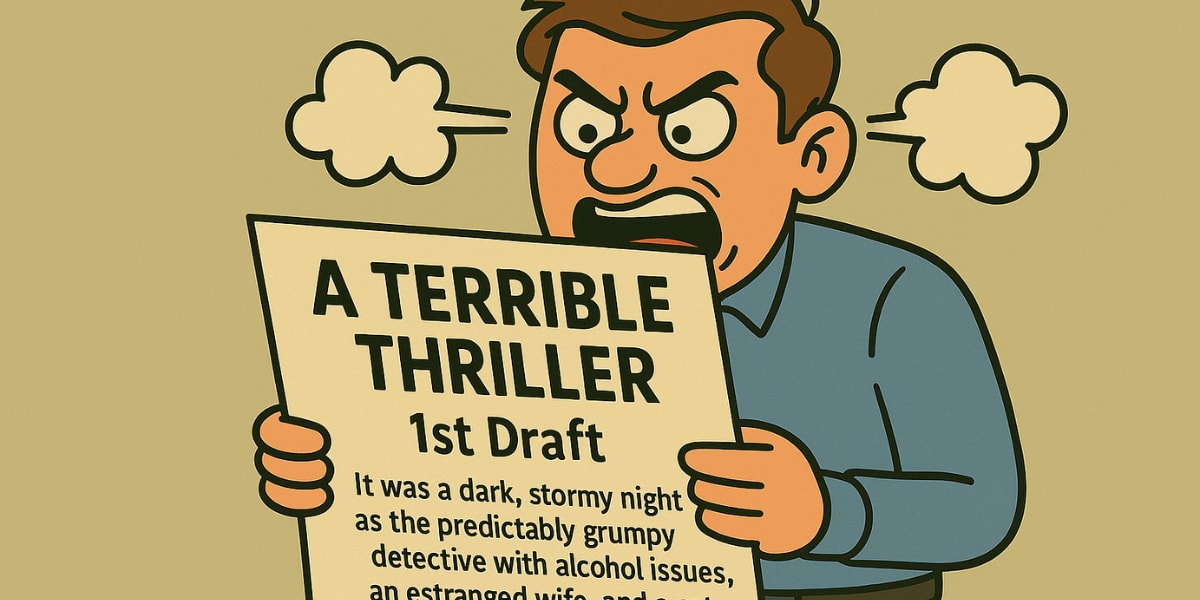The Write Routine
I’m sometimes asked by people (as opposed to animals, plants, or house bricks) what my writing routine is like. So, today I thought I’d share it with you. PART 1, at least.
Now, bear in mind, this is an average week. I do sometimes have a holiday, get ill, or suffer from a hangover, all of which can interrupt my flow.
Monday to Friday (and quite often, Saturday and Sunday)
It’s a job—that’s the first thing I have to say. It’s not a hobby or a pastime, or a fad. This is my livelihood and therefore I must treat it as such. However, the word "job" has negative connotations for a lot of people, and quite rightly so, in my opinion. It conjures up images of long tedious days, performing seemingly futile work as slowly as possible.
You answer to a boss who struggles with the concept of a revolving door, has as much charisma as a pickled walnut, and is not dissimilar in appearance. Then there’s the pay—they don’t pay you what you’re worth, they pay you what they think you’ll accept. After all—there’s a long dole queue out there. And if they did pay you what you were worth, you’d be living in a homeless shelter.
Believe me—I’ve been there, done that, got the t-shirt, tattoo, and nipple piercing to prove it.
Now I’ve lost my train of thought… where was I? Ah, that’s right, a job.
Which means I need to show up on time every day, and work hard. Just because I’m my own boss doesn’t mean I can slack off and binge watch Peaky Blinders, endless YouTube videos of talking cats, or visit websites that give detailed instructions on procreation and the human anatomy.
Not on my watch!
My day begins at 5:00 am when my alarm sounds. I turn it off, and my day begins again at 6:00 am.
This time I mean business.
Shower. Dress (trousers, shirt, socks – not an actual dress). Coffee. Light breakfast. Then into my office. Catch up on the world news for fifteen minutes… ten of which is the football, rugby, and cricket results, then it’s time to work.
What happens next depends on where I am in the writing cycle. If I’m starting a new book or well into it, then I put the blinkers on and neither wild horses nor a chorus line of dancing ladies with mischievous smiles can distract me from that. Not that there are many wild horses or dancing ladies around my neck of the woods. Not mid-week, anyway.
Everything else is put on the back burner.
This is the crucial part.
Without words, there are no books. Without books, there is no income.
I aim for 3k words per day (about two chapters) but often manage 4k or more. On good days, when I’m in the ‘mythical’ zone, I can get up to 7k words down, but that’s rare.
It’s simple maths. On average, my books are about 70k to 80k words long.
In a week – 20k words.
In a month 80k. Which equals a book.
Remember, this is the first draft, which means it is absolute rubbish, codswallop, embarrassingly bad. From the half-way stage right up until the end, I’ll self-flagellate and curse. And the illogical thing is – I go through this every single time. I've now written over twenty-five books (under various guises), so I should know better — but apparently, I’m a slow learner with a short memory.
The first draft is about getting to the end—that is the only objective. Once I’m at the end, then I can start again. However, there’s none as deaf as those who can’t see, and I still grind my teeth and catastrophise.
My wife is used to it by now.
If she unwittingly asks, ‘How’s the book going?’
I’ll tell her the truth.
‘It’s the biggest load of tripe I’ve ever written! It has more plot holes than a daytime soap opera. The characters are so wooden they could audition for Thunderbirds and only get a walk-on part. A party-political broadcast is more believable than this!’
Note: To smartarses everywhere – if you just mumbled ‘Huh, so it doesn’t improve, then?’ – you’re not funny.
My wife will listen patiently, and say something benign, and damned annoying, like, ‘Ah well, I’m sure it will improve,’ then roll her eyes and return to polishing her knuckle-duster.
That is month one.
Month two is the part I enjoy the most.
The second draft is where I take this repulsive monster I’ve spawned and try to mould it into a piece of ugly pottery.
The third draft is when I fine tune the plot, motives, sow the breadcrumbs, leave a few clues for you canny readers to pick up on, and turn the ugly pottery into something you could pick up from a car boot sale on a frosty Sunday morning in Doncaster.
The fourth draft is where I lovingly paint, polish, and buff the final article, while cooing and dribbling like an incoherent father nursing his first-born.
Now we have… not quite a work of art, but possibly something you could buy from B&Q as a wedding gift for someone you don’t like.
Then it’s the tedious stuff; spellcheck, grammar check, dangling modifiers, split-infinitives, ambiguous pronoun references, pleonasms, polysyndetons, polyhedrons, and polygrumbles—to name but two.
After that, it’s time to have some fresh eyes cast a gaze over the manuscript and it’s nearly ready for launch.
Except—it isn’t.
There’s still so much more to do.
But we’ll get to that next time… in Part 2.
